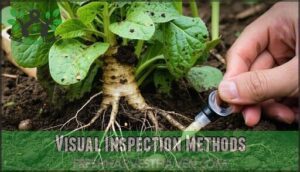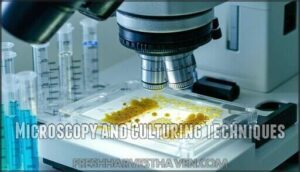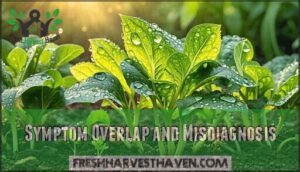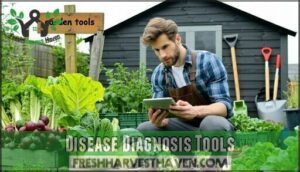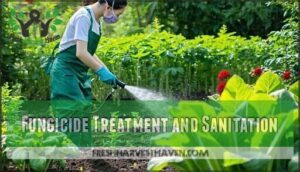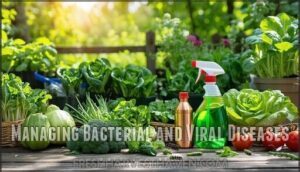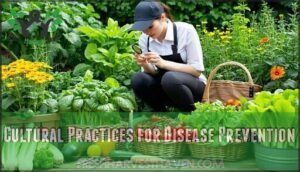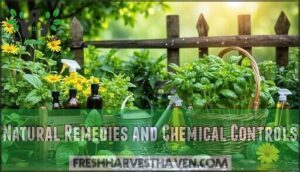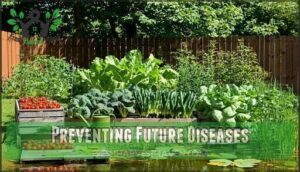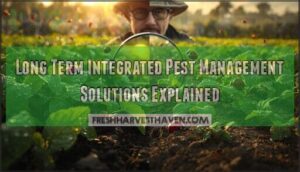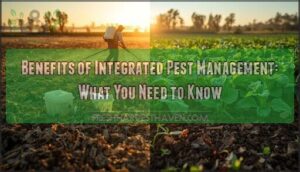This site is supported by our readers. We may earn a commission, at no cost to you, if you purchase through links.
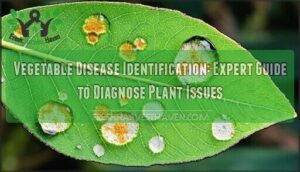
Look for circular spots with dark borders—that’s Septoria leaf spot.
Angular, water-soaked lesions indicate bacterial infections, while white dusty coatings signal powdery mildew.
Viral diseases create distinctive mosaic patterns and yellowing.
Orange-brown pustules on leaf undersides point to rust.
Mobile apps now achieve 93% accuracy using deep learning, making diagnosis easier than ever.
Progressive symptoms suggest active infections, while static spots indicate environmental damage.
Quick identification matters—diseases cause 15-20% of global crop losses annually.
The secret lies in understanding these visual clues and acting fast.
Table Of Contents
- Key Takeaways
- Common Vegetable Diseases
- Identifying Plant Diseases
- Disease Diagnosis Tools
- Treating Vegetable Diseases
- Preventing Future Diseases
- Frequently Asked Questions (FAQs)
- What is plant disease identification?
- How do you know if a plant has a disease?
- What are the three main plant diseases?
- How do plant diseases affect agriculture?
- Which plants are affected by plant disease?
- Why should you know about plant diseases?
- How do I find out what disease my plant has?
- How do you identify a plant disease?
- What is plant ID & Plant Disease ID?
- Why is identifying common plant diseases important?
- Conclusion
Key Takeaways
- Learn the visual clues – You’ll spot fungal diseases by circular spots with dark borders (Septoria), white dusty coatings (powdery mildew), and orange-brown pustules underneath leaves (rust), while bacterial infections show angular, water-soaked lesions.
- Use mobile apps for instant diagnosis – Modern plant scanner apps achieve 93% accuracy using deep learning technology, identifying diseases from photos in under 15 seconds and providing treatment recommendations.
- Act fast to prevent major losses – Early detection matters because plant diseases cause 15-20% of global crop losses annually, and progressive symptoms spreading over time indicate active infections that require immediate treatment.
- Combine multiple diagnostic methods – You’ll get the most accurate results by using visual inspection, mobile apps, and proper sanitation practices together, since misdiagnosis rates reach 20-30% when relying on symptoms alone.
Common Vegetable Diseases
Vegetable diseases can destroy your garden faster than you’d expect, with fungal infections like rust and powdery mildew being the most common culprits you’ll encounter.
Identifying these problems early makes the difference between saving your plants and watching your harvest disappear, which is why early detection is crucial.
Types of Fungal Diseases
Across your vegetable garden, fungal infections plants face threats from several destructive pathogens that can devastate crops.
These microscopic invaders thrive in humid conditions and spread rapidly through spores.
- Rust identification reveals orange-brown pustules on leaf undersides, while ascochitosis symptoms include dark, sunken lesions on stems and pods
- Powdery mildew appears as white, dusty coating on leaves, and downy mildew creates yellow patches with fuzzy growth underneath
- Septoria impact shows circular spots with dark borders, and mold prevention becomes critical in wet seasons
Bacterial and Viral Diseases
Beyond fungal issues, bacterial diseases plants and viral diseases plants create distinct challenges you’ll need to recognize.
Bacterial Symptoms include water-soaked spots and angular lesions, while viral diseases cause mosaic patterns and systemic yellowing.
Understanding Transmission Vectors helps target Prevention Strategies effectively.
| Disease Type | Common Examples | Key Symptoms | Transmission Method |
|---|---|---|---|
| Bacterial | Bacterial spot, bacteriosis | Water-soaked lesions, wilting | Splashing water, tools |
| Viral | Mosaic, TYLCV | Mottling, stunted growth | Aphids, whiteflies |
Bacterial spot affects tomatoes and peppers globally, while cucumber mosaic virus infects over 1,200 plant species.
Disease Resistance varieties reduce bacterial spot incidence by 80%.
Viral Impact can destroy entire crops – TYLCV causes up to 100% yield loss in severe outbreaks.
Symptoms of Leaf Spot Diseases
Leaf spot diseases reveal themselves through distinct visual clues you can learn to read.
Every leaf tells a story – learn to read the warning signs before it’s too late
Spot shapes vary from circular to angular—round spots with target-like rings typically indicate Alternaria fungi, while angular spots suggest downy mildew. Border appearance matters too; sharp, defined edges usually mean one-time injury, but wilted or yellow borders around spots signal active pathogen growth.
Check symptom location carefully—progressive symptoms that spread over time point to infectious disease, while static spots appearing suddenly suggest environmental damage.
Using resistant plant varieties is essential for managing these diseases.
Impact of Diseases on Harvest
Disease impacts aren’t just about spotting symptoms—they directly affect what ends up on your table.
Vegetable diseases cause massive yield reduction, with global crop losses reaching 15-20% annually.
When disease symptoms appear, expect significant economic losses and reduced crop quality.
Poor disease detection leads to market impact through damaged produce.
Late blight alone cuts potato yields by 85%, while bacterial wilt destroys 60% of tomato crops in affected regions, threatening food security and causing significant economic losses due to reduced crop quality.
Plant diseases can wipe out your entire harvest in just days if left unchecked.
Early detection beats desperate rescue efforts every time
Identifying Plant Diseases
You’ll need accurate identification to treat vegetable diseases effectively before they spread throughout your garden.
Modern diagnostic methods range from simple visual inspection to advanced mobile apps that can identify diseases from photos within minutes, utilizing modern diagnostic methods.
Visual Inspection Methods
Your eyes are your first diagnostic tool when examining vegetable disease symptoms.
Start by checking leaf spot shapes – angular spots often signal downy mildew, while round target-like spots suggest Alternaria fungi.
Observe wilting patterns carefully, noting whether it’s partial or complete.
Don’t forget root examination for discoloration.
Watch symptom progression over time, as pathogens spread while injuries remain static.
Check for early morning spores using a hand lens for accurate plant disease identification.
Mobile Apps for Disease Identification
With over 150 plant scanner apps available globally, you’ll find powerful plant disease identification tools at your fingertips.
Leading apps like Plantix achieve 93% app accuracy using deep learning technology trained on thousands of disease images.
These plant scanning technology solutions offer user interface features including instant diagnosis, remedy suggestions, and offline functionality for field use.
Most apps support data privacy protection while providing disease diagnosis for 20+ crops.
Many platforms offer a variety of products related to plant health.
Future development focuses on improving identification of rare diseases and reducing false positives.
Microscopy and Culturing Techniques
Beyond mobile apps, laboratory techniques offer precise disease identification through sample preparation and microscopy.
Light microscopy reveals fungal morphology and spore identification at 40x-1000x magnification, while bacterial culturing on nutrient agar enables pathogen isolation.
These methods provide definitive plant disease diagnosis within hours to days.
Specialized labs may also offer advanced microscopy solutions for detailed analysis.
- See the invisible enemy: Microscopy exposes hidden fungal hyphae threading through your plant’s tissues
- Grow the culprit: Bacterial culturing transforms mysterious symptoms into identifiable colonies you can actually see
- Stop the guesswork: Laboratory confirmation ends the frustration of treating the wrong disease
- Save your harvest: Accurate pathogen isolation means targeted treatment that actually works
Symptom Overlap and Misdiagnosis
Diagnostic challenges arise when similar visual symptoms appear across multiple diseases, creating confusion during plant disease diagnosis.
You’ll encounter atypical symptoms that don’t match textbook descriptions, making disease identification tricky.
Environmental influence affects symptom severity, while varietal resistance can mask typical signs.
Field surveys show misdiagnosis rates of 20-30% due to symptom overlap between different pathogens.
Disease Diagnosis Tools
Modern technology transforms disease diagnosis from guesswork into precise science. You’ll discover digital tools that identify plant problems faster and more accurately than traditional methods ever could.
Plant Scanners and ID Features
Today’s plant scanners deliver impressive accuracy rates up to 97% for common vegetable diseases through advanced machine learning algorithms.
These mobile apps process images in under 15 seconds, identifying over 150 different diseases using multi-spectral imaging technology.
However, scanner accuracy drops with poor lighting conditions, and app limitations include offline functionality gaps.
Prevention relies on proper watering and sunlight to strengthen plant defenses.
Feature comparison reveals that while free apps handle basic plant disease identification, premium versions offer enhanced plant disease diagnostic tools and techniques for professional growers seeking thorough plant identification capabilities.
Expert Tips for Disease Prevention
You’ll prevent most vegetable diseases by focusing on soil health and choosing varieties with disease resistance.
Monitor crops weekly for early symptoms like leaf spots or wilting. Maintain proper plant spacing for air circulation and rotate crops annually.
Clean tools between plants to prevent pathogen spread. These plant disease prevention strategies form your first line of defense.
Effective disease prevention tools can also aid in protecting your crops from various threats, which is a key part of disease prevention and supports overall crop protection and plant health.
Cloud-Based Platforms for Instant Diagnoses
Cloud-based platforms revolutionize plant disease identification with machine learning models achieving 85-95% diagnostic accuracy in under 10 seconds.
These agricultural technology solutions support over 25 languages, enhancing platform accessibility globally.
While user experience improves through instant feedback, data security concerns and cost effectiveness remain considerations.
Over 70% of crop management platforms now integrate these vegetable disease diagnostic tools.
Treating Vegetable Diseases
Once you’ve identified the disease affecting your vegetables, you’ll need to choose the right treatment approach based on whether it’s fungal, bacterial, or viral.
Effective prevention combines immediate action with long-term strategies to stop disease spread and protect your remaining crops.
Fungicide Treatment and Sanitation
When fungal infections strike your vegetables, you’ll need targeted fungicide treatment and thorough sanitation methods.
Apply fungicides during cool morning hours to prevent leaf burn and make certain safe application. Rotate between alternative fungicides to avoid fungicide resistance in pathogens.
FRAC codes are important to prevent resistance.
Remove infected plant debris immediately and sterilize tools between plants. Post-treatment care includes monitoring for disease recurrence and maintaining proper plant sanitation throughout the growing season to ensure disease-free growth.
Managing Bacterial and Viral Diseases
Unlike fungal infections, bacterial and viral diseases demand different approaches.
You can’t cure viral diseases once they infect your plants, so focus on prevention through resistant varieties and controlling viral vectors like aphids and whiteflies.
For bacterial diseases, copper-based sprays offer some control, but sanitation importance can’t be overstated.
Remove infected plants immediately to prevent spread.
Integrated management combining vector control, resistant varieties, and strict sanitation protocols reduces bacterial control challenges substantially.
Cultural Practices for Disease Prevention
When you build strong defenses early, diseases can’t get a foothold in your garden.
Crop rotation breaks pathogen cycles by moving plant families to different beds each season.
Choose resistant varieties that naturally fight off common diseases.
Proper spacing improves airflow between plants, reducing moisture that fuels infections.
Keep tools clean between plants to prevent spreading pathogens.
Maintain soil health through composting and testing.
Natural Remedies and Chemical Controls
Several effective treatments target plant diseases using both natural and chemical approaches.
Natural remedies offer gentler solutions, while chemical controls provide stronger intervention when needed.
Top natural disease treatments:
- Neem Oil – Acts as natural fungicide and insect repellent, reducing virus transmission by 45-70%
- Milk Solution – Mix 50:50 with water to cut powdery mildew severity by 40-60%
- Cornell Formula – Combines baking soda, horticultural oil, and soap for broad-spectrum protection
Copper sprays and sulfur dust provide chemical remedies for stubborn infections, achieving 60-80% efficacy against bacterial spot and early blight.
You can find various neem oil products online.
Preventing Future Diseases
You can prevent most vegetable diseases by staying ahead of problems before they start damaging your crops.
Smart prevention strategies save time, money, and heartache compared to treating diseases after they’ve taken hold.
Proper Tool Use and Inspection
You’ll need the right plant disease identification tools and proper inspection techniques to catch problems early.
Clean, sharp tools prevent disease spread between plants. Regular visual inspection catches symptoms before they progress.
| Tool | Purpose | Inspection Focus |
|---|---|---|
| Hand lens | Spore identification | Leaf spots, fruiting bodies |
| Pruning shears | Root examination | Stem discoloration, root rot |
| Soil testing kit | Symptom progression | pH levels, nutrient deficiency |
Tool maintenance keeps your diagnostic equipment accurate and prevents cross-contamination during plant inspection sessions.
Early Detection and Monitoring Techniques
Regular plant disease monitoring prevents small problems from becoming crop disasters.
Visual inspection remains your primary detection method, but modern technology amplifies your diagnostic power substantially.
- Weekly visual inspection of all plant parts for early symptom detection
- Remote sensing technology tracks disease spread across large growing areas
- Sensor technology monitors environmental conditions that trigger disease outbreaks
- Citizen science apps help identify plant disease symptoms through community databases
- Predictive modeling forecasts disease pressure based on weather patterns and historical data
Informed Treatment Decisions and Outcomes
Once you’ve identified the disease, making smart treatment choices directly impacts your harvest success.
Treatment efficacy depends on selecting the right approach for each pathogen type.
| Disease Type | Treatment Method | Expected Outcome |
|---|---|---|
| Fungal infections | Copper-based sprays + sanitation | 70-85% yield improvement |
| Bacterial diseases | Resistant varieties + IPM | 60-75% disease resistance |
| Viral pathogens | Remove infected plants early | Prevents 90% spread to healthy crops |
| Root rot issues | Improve drainage + fungicides | 50-65% plant recovery rate |
| Powdery mildew | Milk spray (50:50 water mix) | 80% symptom reduction in 2 weeks |
Your vegetable disease identification skills pay off when you match treatments to specific problems. Disease management strategies that target the actual pathogen show better long-term effects than broad-spectrum approaches.
Economic impact improves substantially when you choose plant disease control strategies based on accurate diagnosis rather than guessing. This approach ensures that your efforts are focused on the most effective solutions, leading to improved harvest outcomes.
Using Technology for Plant Health Monitoring
Plant health monitoring systems now harness AI diagnostics and remote sensing to detect diseases before symptoms appear.
Drone surveillance covers 50 acres per flight, while precision agriculture reduces fungicide use by 40%.
Data analysis from wireless sensors provides disease warnings 7-10 days earlier than visual inspection.
These plant disease monitoring technologies achieve 95% accuracy in automated detection.
Understanding the importance of proper plant hygiene is also essential for disease prevention.
Frequently Asked Questions (FAQs)
What is plant disease identification?
Like a detective solving a mystery, plant disease identification involves examining your plants for telltale symptoms like leaf spots, wilting, and discoloration.
You’ll use visual inspection, apps, or expert guides to diagnose what’s affecting your crops and determine proper treatment.
How do you know if a plant has a disease?
Look for visual symptoms like leaf spots, yellowing, wilting, or unusual growths.
Check all plant parts – leaves, stems, roots, and fruits.
Progressive symptoms that spread over time typically indicate disease rather than environmental stress, and such symptoms are often characterized by unusual growths.
What are the three main plant diseases?
Don’t put all your eggs in one basket when identifying plant threats.
The three main plant diseases are fungal infections (like powdery mildew and rust), bacterial diseases (such as bacterial wilt), and viral diseases (including mosaic viruses).
How do plant diseases affect agriculture?
Plant diseases slash global agricultural production by 15-20% annually, costing farmers billions.
You’ll see fungal infections destroying 70% of vegetable crops, while bacterial wilt devastates tomato yields by 60% in Southeast Asia alone.
Which plants are affected by plant disease?
Every plant’s like a sitting duck for disease – vegetables, houseplants, trees, cereals, and flowers all face threats from fungi, bacteria, viruses, and nematodes that can devastate crops worldwide.
Why should you know about plant diseases?
You’ll save money and frustration by catching diseases early. Plant diseases cause 15-20% global crop losses annually, but early identification lets you treat problems before they destroy your entire harvest.
How do I find out what disease my plant has?
Tiny spots scattered across wilted leaves tell stories of hidden invaders.
Start by inspecting all plant parts carefully for symptoms like discoloration, lesions, or abnormal growth patterns.
Use plant identification apps or consult disease guides for accurate diagnosis.
How do you identify a plant disease?
Examine your plant’s leaves, stems, and roots for spots, discoloration, wilting, or abnormal growth patterns.
Use visual inspection, hand lens for spores, and mobile apps for accurate identification and treatment recommendations.
What is plant ID & Plant Disease ID?
Unlike guessing games, plant ID and disease ID apps use image recognition technology to instantly identify your plants and diagnose health problems through photos.
Eliminating uncertainty and providing expert-level botanical knowledge.
Why is identifying common plant diseases important?
Early disease identification prevents crop losses that cost farmers billions annually. You’ll catch problems before they spread, saving time and money while protecting your harvest from devastating damage.
Conclusion
Mastering vegetable disease identification isn’t rocket science, but it’s absolutely essential for your garden’s survival.
You’ve learned to spot fungal infections, bacterial blights, and viral patterns through visual cues and modern technology.
Mobile apps make diagnosis lightning-fast with 93% accuracy rates.
Remember that early detection saves crops—diseases destroy billions in harvests annually.
Practice these identification techniques regularly, maintain clean tools, and don’t hesitate to seek expert help when symptoms puzzle you.

